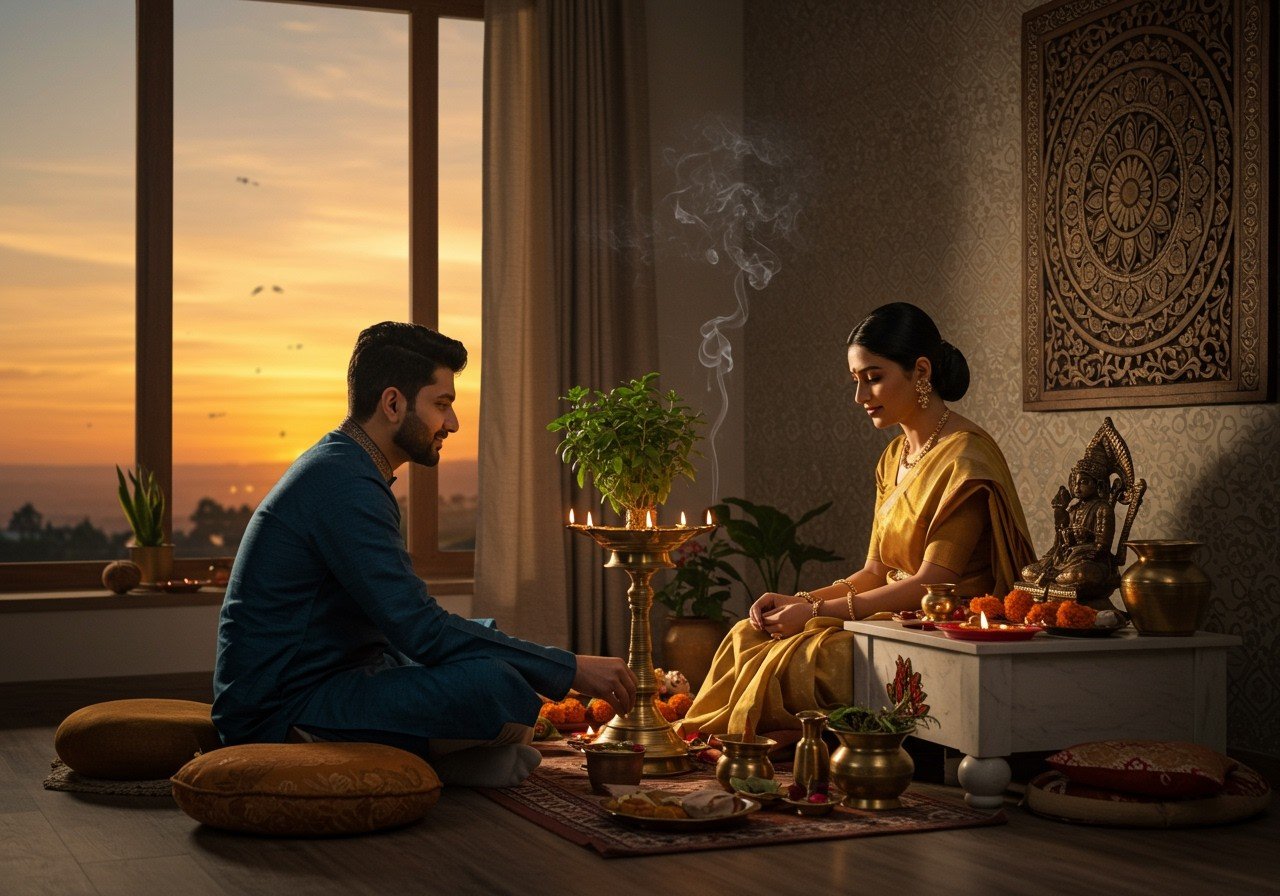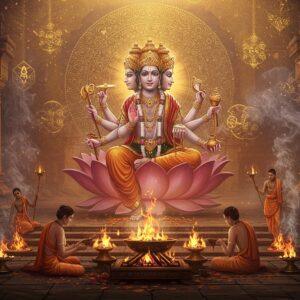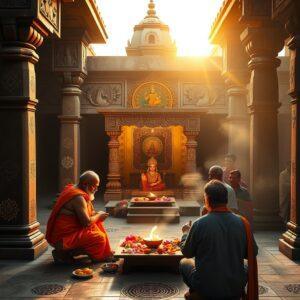Embracing the Grhastha Ashrama: A Guide to Hindu Householder Life

In Hindu philosophy, life is divided into four stages, known as ashramas. The Grhastha Ashrama, the second stage, centers around family life and responsibilities. This period emphasizes fulfilling worldly duties, nurturing family, and living righteously. Understanding the Grhastha Ashrama allows us to appreciate its role within the broader context of Brahmacharya (student life), Vanaprastha (hermit stage), and Sannyasa (renounced life).
Daily Observances and Rituals for the Householder
Daily rituals and pujas are integral to a householder’s life. Sandhyavandanam, prayers offered at dawn and dusk, helps maintain spiritual equilibrium. This practice connects individuals with the divine and sets a positive tone for the day. Agnihotra, a fire ritual, purifies the home and surroundings. This symbolic act cleanses the environment and promotes spiritual well-being. Tulsi Puja, reverence for the holy basil plant, is believed to invite prosperity and safeguard the family. This simple act connects the householder with nature and the divine.
Griha Pravesh, the housewarming ceremony for new homes, purifies and blesses the space. Regular worship of family deities and maintaining a home shrine are vital for spiritual discipline. These practices cultivate values and unite the family in shared spiritual growth. They create a sacred space within the home and foster a sense of reverence.
The transition into family life often involves Hindu marriage rituals and customs. These ceremonies mark a significant milestone in a householder’s life.
Hindu Marriage Rituals and Customs
A Hindu wedding is a vibrant celebration of traditions, signifying joy, unity, and the start of a shared journey. While regional variations exist, certain customs remain timeless, connecting families and cultures. These rituals are a beautiful expression of love, commitment, and cultural heritage.
Pre-Wedding Rituals
- Engagement/Roka: This ceremony formally announces the consent between the bride and groom. Families gather to exchange gifts and bless the couple. A Pandit (priest) conducts a puja for divine blessings, and the couple exchanges rings, marking the beginning of their journey together.
- Mehndi Ceremony: The bride’s hands are adorned with intricate mehndi (henna) designs, symbolizing positivity and good fortune. The groom may also participate. The deeper the bride’s mehndi color, the more joyful the marriage is believed to be. This vibrant tradition adds beauty and meaning to the pre-wedding festivities.
- Haldi Ceremony: Close relatives apply a turmeric paste to the bride and groom. This ceremony is filled with music, dance, and joyful celebration. The turmeric symbolizes purification and blessings for the couple’s future.
- Aashirwad: This ceremony confirms the marriage alliance a day or two before the wedding. Hosted at either the bride’s or groom’s home, the bride receives a sari, and the groom is presented with a ring, gold buttons, and a watch, signifying the families’ blessings and acceptance.
- Varyatra/Baraat: This marks the groom’s arrival at the bride’s residence, often a grand procession filled with music, dance, and celebration. It signifies the groom’s journey to begin his new life with his bride.
- Ritual Baths: Both the bride and groom undergo ritual baths with turmeric, oil, and water, applied by married women. This act of purification prepares them for the wedding ceremony. Both wear new clothes, symbolizing a fresh start.
Wedding Ceremony Rituals
- Welcoming the Groom (Var Āgamān or Swāgatam): The groom is greeted with conch shells, bells, and ululation. The mistress of the house performs a silver plate ritual, touching the groom’s forehead, the ground, and back to his forehead three times, offering sweets as a warm welcome.
- Ganesha Puja: Prayers are offered to Lord Ganesha, the remover of obstacles, to bless the wedding ceremony and the couple’s future together. This invokes divine blessings for a smooth and harmonious start to married life.
- Kanyadaan: The bride’s father gives her hand in marriage to the groom, symbolizing a new beginning and entrusting her care to her husband. If the father is deceased, a chosen guardian performs the ritual. Holy water is poured, signifying the bride’s transition into a new life.
- Hasta Milap/Panigrahana: The couple’s right hands are joined, and water is sprinkled, signifying unity and an unbreakable bond. This act represents their commitment to each other and their shared journey.
- Vivaha Homa (Sacred Fire Ritual): The priest lights a sacred fire, invoking Lord Agni as a witness. This ritual symbolizes the presence of the divine and the sanctity of the marriage vows.
- Mangalphera/Agniparinayana/Pradakshina/Parikrama: The couple circles the sacred fire, typically four times. Each round signifies one of life’s four goals: Dharma (righteousness), Artha (prosperity), Kama (desire/happiness), and Moksha (spiritual liberation). The bride leads the first three rounds and the groom the last, demonstrating their shared commitment to these principles.
- Saptapadi: The couple takes seven steps together, making vows for their future. After each vow, they perform agnipradakshinam, circling the fire. These seven steps represent their journey together and their commitment to support each other.
- Sindoor and Mangalsutra: The groom applies sindoor (vermillion) to the bride’s forehead and ties the mangalsutra (sacred necklace) around her neck, symbolizing their union and his lifelong commitment to her.
Post-Wedding Rituals
- Blessings and Gifts: The newlyweds seek blessings from elders and deities, particularly Lord Vishnu and Goddess Lakshmi, for a prosperous and happy life together. The bride receives gifts of jewelry and clothing from her new family, signifying acceptance and love. These gestures strengthen the bond between the families and symbolize the bride’s new beginning.
How Poojn.in Supports Your Grhastha Dharma
Poojn.in offers comprehensive support for all rituals and practices during the Grhastha phase. As India’s largest Dashakarma bhandar, we provide:
- Essential Puja Kits: Pre-assembled kits for Lakshmi Puja (Shop Now), Ganesh Puja, and Shiv Puja, along with custom kits for specific ceremonies.
- Ritual Items: Pure copper and brass items, diya and agarbatti stands, puja thalis, and sacred items for home temples are available. You can find all your daily worship needs at Poojn.in.
- Festival and Ceremony Supplies: Dashakarma kits for festivals, Griha Pravesh materials, marriage ceremony essentials, and birth ceremony items (Explore our Saraswati Puja Kit) can be found on our site.
Visit Poojn.in for our complete range of authentic puja items, delivered across India.
Blending Tradition with Modernity
As you enter the Grhastha Ashrama, these timeless rituals provide a foundation for your new life. They honor Hindu traditions while embracing modern life. Each ceremony weaves a tapestry of love, respect, and shared values, ensuring strong family and cultural bonds. Respecting these customs enriches your journey, creating lasting memories. May your path be filled with happiness, prosperity, and ancestral blessings. Find everything you need to observe these sacred traditions at Poojn.in.
FAQs about Grhastha Ashrama Rituals
What are Grhastha Ashrama rituals? Grhastha Ashrama rituals are traditional practices for householders, encompassing daily pujas, family festivals, and ceremonies honoring ancestors and deities. They are essential for maintaining spiritual balance and harmony within the home.
How can modern Hindus practice daily pujas? Modern Hindus can designate a dedicated space in their home for puja. Simple rituals with incense (like sandalwood agarbatti), flowers, and a diya help maintain a daily connection with the divine, even with busy schedules.


